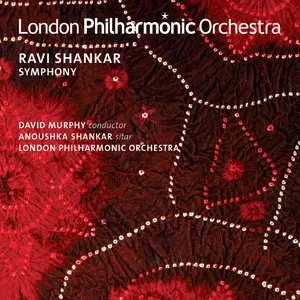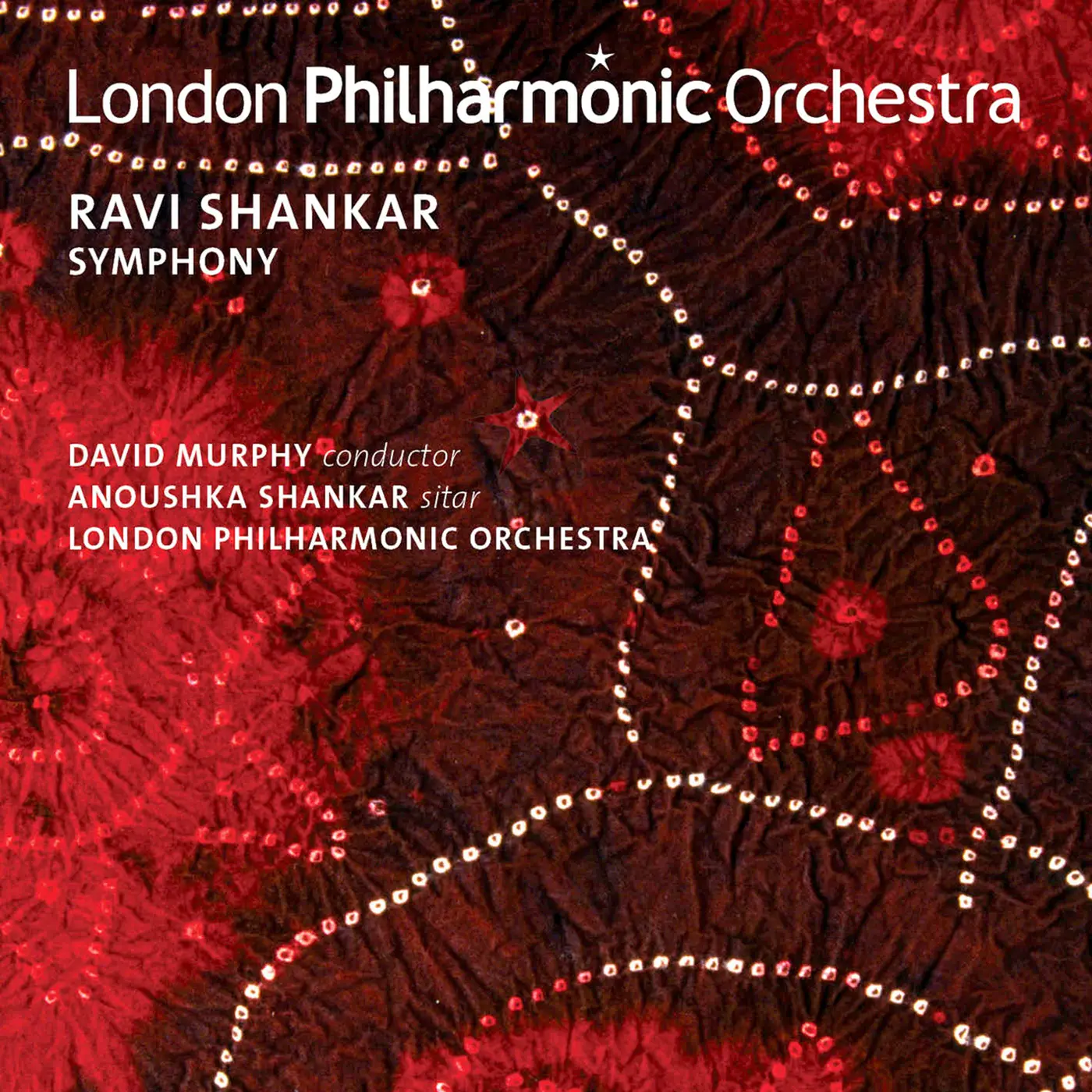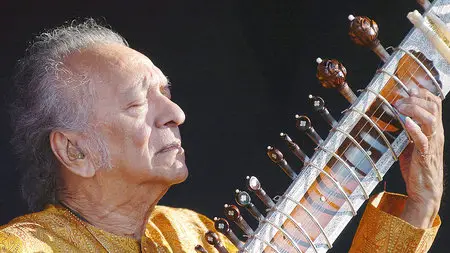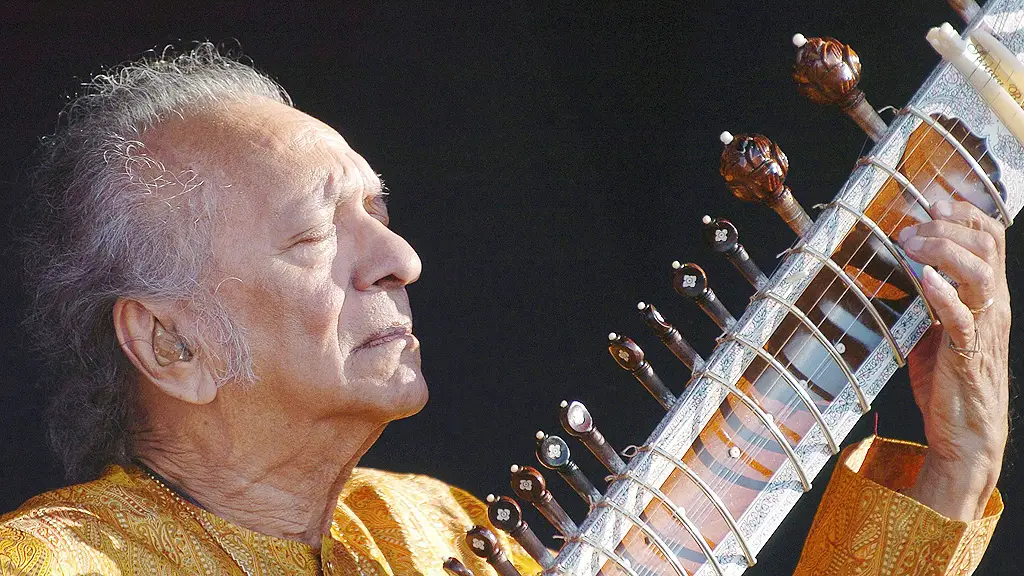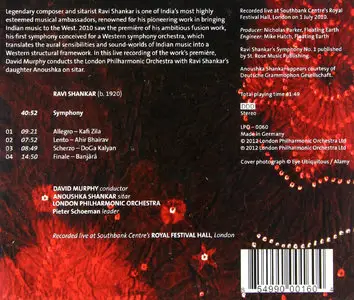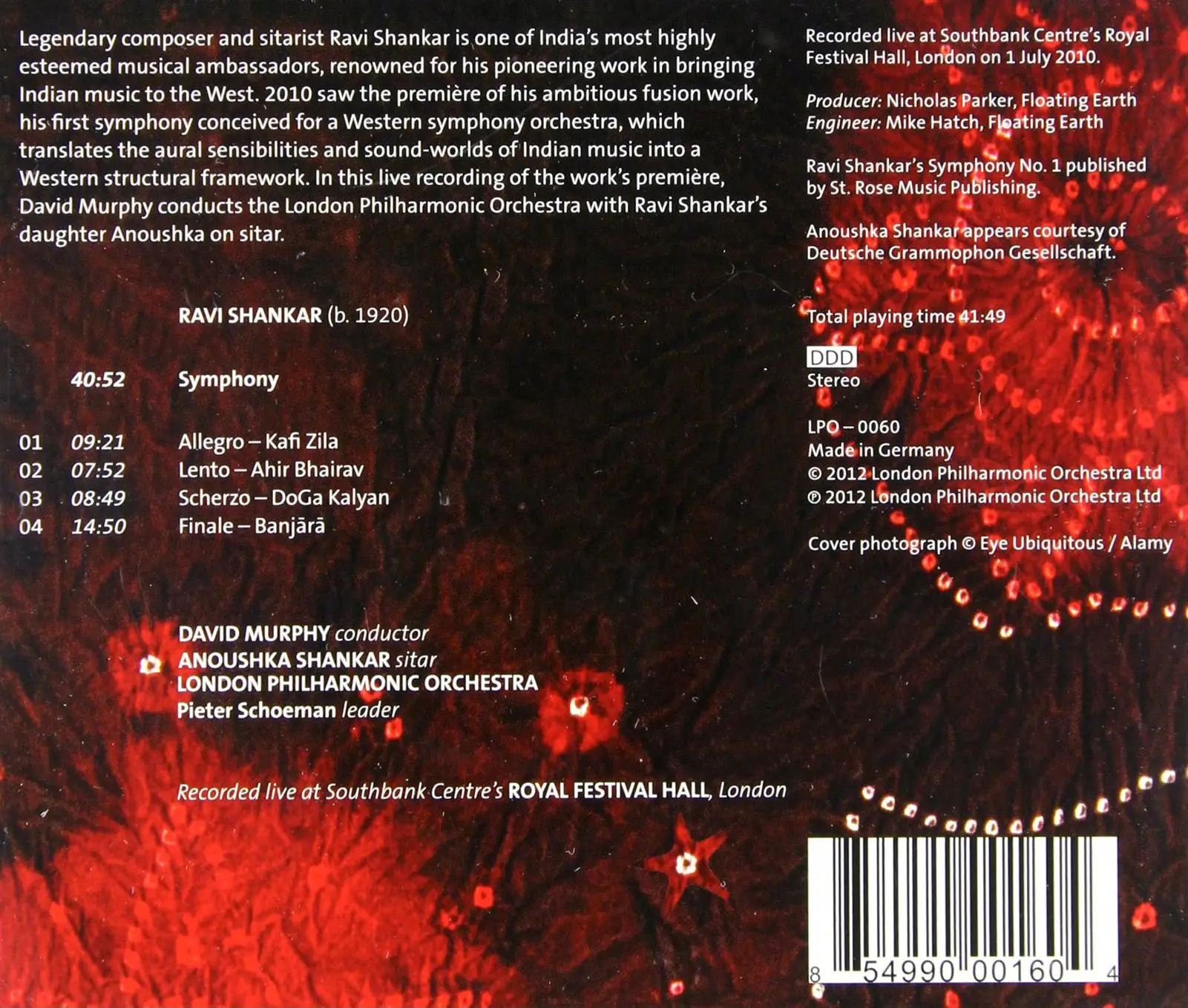London Philharmonic Orchestra, David Murphy, Anoushka Shankar - Ravi Shankar: Symphony (2012)
EAC | FLAC | Image (Cue&Log) ~ 211 Mb | Mp3 (CBR320) ~ 100 Mb | Scans included
Classical, Indian Traditions | Label: London Philharmonic Orchestra | # LPO-0060 | 00:41:49
EAC | FLAC | Image (Cue&Log) ~ 211 Mb | Mp3 (CBR320) ~ 100 Mb | Scans included
Classical, Indian Traditions | Label: London Philharmonic Orchestra | # LPO-0060 | 00:41:49
First and only available recording of this most anticipated work by one of India's best known composers, Ravi Shankar. Featuring the dazzling sitar playing of Anoushka Shankar - whose recordings on the Deutsche Grammophon label include the Grammy nominated, Live at Carnegie Hall. In this live recording of the work's premiere, David Murphy conducts the London Philharmonic Orchestra with Ravi Shankar's daughter Anoushka on sitar.
It would be hard to overstate the significance Ravi Shankar has had in introducing Indian classical music to Western music, both pop and classical, because of his strong impact on the music and aesthetic of George Harrison and Philip Glass, and the breadth of their consequent influence. Shankar had written three concertos for sitar and orchestra, but this piece, premiered in 2010 by the forces that recorded it here, is his first symphony. It resembles a symphony in the fact that it has four movements: "faster outer movements, a lyrical second movement, and a third movement structured along the lines of a scherzo and trio." With the prominence of the sitar, though, the work has more the feel of a concerto. How it is defined in technical terms, though, is less important than the fact that it's a thoroughly engaging work, immediately accessible, with an appealing melodic directness. Each distinctive movement is based on a traditional raga, or melodic mode, so the work's non-Western roots are immediately recognizable. Shankar is successful in adapting the melodic and harmonic characteristics of the Indian classical tradition to a Western orchestra and in using the solo sitar as a complement to the orchestra. The piece ends with a delightful surprise that it would be unfair to spoil by describing here.
David Murphy leads the London Philharmonic Orchestra in a polished performance that demonstrates sensitivity to the idiomatic writing, which incorporates devices from Indian classical music such as slides and bent tones. The composer's daughter Anoushka Shankar delivers a stellar performance of the solo part. She is an acknowledged virtuoso sitar player in the classical tradition and she also has a history of integrating Western popular styles, such as flamenco, with the music for her instrument. The contrast between the acoustic sound of the orchestra and the obviously amplified sound of the sitar may require some aural adjustment. The sound of the live performance is clean and detailed.Review by Stephen Eddins, Allmusic.com
This is one of those CDs you almost feel lucky to have in existence, as it preserves a moment in time and a work that may be a game-changer for future composers wishing to coalesce Western and Indian music. Ravi Shankar, one of the world’s music legends—partly for the right reasons, and partly for the wrong reasons—composed this work in which he united his two lifelong passions, Western classical music (his early idols included Enescu, Toscanini, Heifetz, Paderewski, Casals, Kreisler, and Chaliapin) and Indian ragas. What’s significant about this work is that he waited until he was 90 years old to write it.
One might think that an Eastern classical musician schooled in a different discipline would have difficulty, at 90 or any age, in fusing the two types of music, but Shankar has always been able to understand and intellectualize the differences between them. He has known for decades that the Western ear is attuned to harmony, modulation, and counterpoint, thus when he gave his sitar concerts—even way back in the 1960s—he patiently explained the differences to his Western audiences before playing.
This recording is the actual premiere, given at London’s Royal Festival Hall in July 2010. The demanding and highly virtuosic sitar solos are played by his daughter, Anoushka, who by contrast with her father had celebrated her 29th birthday less than a month earlier.
“This was conceived entirely for the Western symphony orchestra, so I had to eliminate the traditional Indian instruments but transfer some of their spirit onto the Western instruments,” Shankar told BBC radio on the day of the premiere. “I wrote it in Indian notation, which David Murphy, who is a student of mine and a wonderful conductor, has interpreted very well.”
The first movement, in particular, reminds one strongly of Minimalism, which isn’t surprising when one realizes that Philip Glass was one of many Western musicians who were heavily influenced by Shankar back in the 1960s. Based largely on a raga known as Kafi Zila, similar to the natural minor scale in Western music, it relies very heavily (at least at first) on repeated ostinato figures. Happily, as the movement goes on, it departs from the principles of Minimalism by actually developing its themes using an 11-beat meter with an extended solo for the sitar. Anoushka Shankar’s playing is extremely fluent in technique and rapt in feeling. It is not an exaggeration to say that she not only elevates this music, but that it would be difficult to hear the solo portions played by any lesser musician.
As the second movement (Lento) begins, one feature that strikes the listener is that unlike most Western symphonies, which cast alternate movements or alternate sections within a one-movement symphony in different keys, Shankar has chosen to present both movements in a key, or mode, similar to D Major. This movement, based on a devotional raga called Ahir Bhairav with a flattened second and seventh, has an extremely hypnotic effect. One is drawn into its calm lyricism to such an extent that its nearly eight minutes seem to fly by in half that time. Before you know it, the orchestra is beating the lively rhythm of the Raga DoGo Kalyan in the third movement, which uses the metric division of 2+3+2+3. Shankar’s use of this slightly tricky rhythm is artfully combined with very inventive motifs (I wouldn’t go so far as to call them “themes” in the Western sense), which, like the exciting rhythm, pile one on top of the other to create a new kind of building effect. In the trio section (such as it is), the solo sitar combines its sound with a marimba and xylophone.
This movement, too, tends toward D, as does the final movement. Yet because each movement uses a different raga as its basis (the fourth uses the Raga Banj?r? , which has a flatted sixth and employs a lively folk beat), every movement sounds different from the others. Interestingly, this movement begins quietly, lyrically, lulling the listener into a state of relaxation from which Shankar only gradually moves into a livelier beat. If you listen carefully, he manages this transformation with much the same skill that Schubert used in the first movement of his great Ninth Symphony. One major difference is that Shankar also composed a contrasting lyrical section for the center of the movement as well, assigned, once again, to the solo sitar.
To a very large extent, then, Shankar’s symphony is a work for soloist and orchestra in the same sense as Berlioz’s “symphony” Harold in Italy. Thus any future performances will have to rely not only on the complete understanding of a sympathetic and Indian-music-oriented conductor, but also on a virtuosic sitarist of the caliber of Anoushka. This is a tremendous challenge, and also presumes that the sitar soloist will have as fine a grasp of Western classical form as Anoushka Shankar. For that reason alone, I foresee problems in spreading this music across the globe and presenting it with other Western orchestras, but you never know. Anoushka is young enough that she just might produce an entire school of such musicians. Highly recommended.Review by Lynn René Bayley, Fanfare
Anoushka Shankar, sitar
London Philharmonic Orchestra
David Murphy, conductor
Tracklist:
Ravi Shankar - Symphony No.1:
01. Allegro - Kafi Zila (09:21)
02. Lento - Ahir Bhairav (07:51)
03. Scherzo - DoGa Kalyan (08:48)
04. Finale - Banjara (15:47)
Exact Audio Copy V1.0 beta 4 from 7. December 2014
EAC extraction logfile from 29. November 2015, 14:35
Ravi Shankar / Symphony
Used drive : TSSTcorpDVDWBD TS-LB23A Adapter: 1 ID: 0
Read mode : Secure
Utilize accurate stream : Yes
Defeat audio cache : Yes
Make use of C2 pointers : No
Read offset correction : 6
Overread into Lead-In and Lead-Out : No
Fill up missing offset samples with silence : Yes
Delete leading and trailing silent blocks : No
Null samples used in CRC calculations : Yes
Used interface : Native Win32 interface for Win NT & 2000
Used output format : User Defined Encoder
Selected bitrate : 128 kBit/s
Quality : High
Add ID3 tag : Yes
Command line compressor : C:\Program Files (x86)\Exact Audio Copy\Flac\flac.exe
Additional command line options : -T "COMMENT=Ripped by GFox" -V -8 %source%
TOC of the extracted CD
Track | Start | Length | Start sector | End sector
––––––––––––––––––––––––––––-
1 | 0:00.00 | 9:21.37 | 0 | 42111
2 | 9:21.37 | 7:51.66 | 42112 | 77502
3 | 17:13.28 | 8:48.52 | 77503 | 117154
4 | 26:02.05 | 15:47.13 | 117155 | 188192
Range status and errors
Selected range
Filename D:\Downloads\Ravi Shankar - Symphony.wav
Peak level 100.0 %
Extraction speed 1.4 X
Range quality 99.9 %
Test CRC BEFCA2D9
Copy CRC BEFCA2D9
Copy OK
No errors occurred
AccurateRip summary
Track 1 accurately ripped (confidence 7) [F65B231A] (AR v2)
Track 2 accurately ripped (confidence 7) [7CFC7079] (AR v2)
Track 3 accurately ripped (confidence 7) [3E35BC98] (AR v2)
Track 4 accurately ripped (confidence 7) [6E4B9F86] (AR v2)
All tracks accurately ripped
End of status report
==== Log checksum 1B7687637A6A162F3E40F1E03C7A07CF905984F47D7EFDFDED4D3D615D51AFD1 ====
EAC extraction logfile from 29. November 2015, 14:35
Ravi Shankar / Symphony
Used drive : TSSTcorpDVDWBD TS-LB23A Adapter: 1 ID: 0
Read mode : Secure
Utilize accurate stream : Yes
Defeat audio cache : Yes
Make use of C2 pointers : No
Read offset correction : 6
Overread into Lead-In and Lead-Out : No
Fill up missing offset samples with silence : Yes
Delete leading and trailing silent blocks : No
Null samples used in CRC calculations : Yes
Used interface : Native Win32 interface for Win NT & 2000
Used output format : User Defined Encoder
Selected bitrate : 128 kBit/s
Quality : High
Add ID3 tag : Yes
Command line compressor : C:\Program Files (x86)\Exact Audio Copy\Flac\flac.exe
Additional command line options : -T "COMMENT=Ripped by GFox" -V -8 %source%
TOC of the extracted CD
Track | Start | Length | Start sector | End sector
––––––––––––––––––––––––––––-
1 | 0:00.00 | 9:21.37 | 0 | 42111
2 | 9:21.37 | 7:51.66 | 42112 | 77502
3 | 17:13.28 | 8:48.52 | 77503 | 117154
4 | 26:02.05 | 15:47.13 | 117155 | 188192
Range status and errors
Selected range
Filename D:\Downloads\Ravi Shankar - Symphony.wav
Peak level 100.0 %
Extraction speed 1.4 X
Range quality 99.9 %
Test CRC BEFCA2D9
Copy CRC BEFCA2D9
Copy OK
No errors occurred
AccurateRip summary
Track 1 accurately ripped (confidence 7) [F65B231A] (AR v2)
Track 2 accurately ripped (confidence 7) [7CFC7079] (AR v2)
Track 3 accurately ripped (confidence 7) [3E35BC98] (AR v2)
Track 4 accurately ripped (confidence 7) [6E4B9F86] (AR v2)
All tracks accurately ripped
End of status report
==== Log checksum 1B7687637A6A162F3E40F1E03C7A07CF905984F47D7EFDFDED4D3D615D51AFD1 ====
[CUETools log; Date: 17.12.2024 16:36:16; Version: 2.1.7]
[CTDB TOCID: ntPeZICcZzU3K6PKKyAFcUKa_40-] found.
Track | CTDB Status
1 | (34/35) Accurately ripped
2 | (34/35) Accurately ripped
3 | (34/35) Accurately ripped
4 | (34/35) Accurately ripped
[AccurateRip ID: 00067c03-001a576f-2909cd04] found.
Track [ CRC | V2 ] Status
01 [a8c48030|f65b231a] (00+16/19) Accurately ripped
02 [75575056|7cfc7079] (00+16/19) Accurately ripped
03 [54d0f5ac|3e35bc98] (00+15/18) Accurately ripped
04 [e050f38d|6e4b9f86] (00+16/19) Accurately ripped
Offsetted by -90:
01 [9931414c] (00/19) No match (V2 was not tested)
02 [ece44d92] (00/19) No match (V2 was not tested)
03 [3a4fce1d] (00/18) No match (V2 was not tested)
04 [4e97f53d] (00/19) No match (V2 was not tested)
Track Peak [ CRC32 ] [W/O NULL] [ LOG ]
– 100,0 [BEFCA2D9] [B7F33972] CRC32
01 100,0 [9E33E35C] [440DB0E2]
02 41,0 [EBFDDD7E] [076EA244]
03 100,0 [15E5FD79] [30EAAEC2]
04 100,0 [676392FE] [CA8F1C13]
[CTDB TOCID: ntPeZICcZzU3K6PKKyAFcUKa_40-] found.
Track | CTDB Status
1 | (34/35) Accurately ripped
2 | (34/35) Accurately ripped
3 | (34/35) Accurately ripped
4 | (34/35) Accurately ripped
[AccurateRip ID: 00067c03-001a576f-2909cd04] found.
Track [ CRC | V2 ] Status
01 [a8c48030|f65b231a] (00+16/19) Accurately ripped
02 [75575056|7cfc7079] (00+16/19) Accurately ripped
03 [54d0f5ac|3e35bc98] (00+15/18) Accurately ripped
04 [e050f38d|6e4b9f86] (00+16/19) Accurately ripped
Offsetted by -90:
01 [9931414c] (00/19) No match (V2 was not tested)
02 [ece44d92] (00/19) No match (V2 was not tested)
03 [3a4fce1d] (00/18) No match (V2 was not tested)
04 [4e97f53d] (00/19) No match (V2 was not tested)
Track Peak [ CRC32 ] [W/O NULL] [ LOG ]
– 100,0 [BEFCA2D9] [B7F33972] CRC32
01 100,0 [9E33E35C] [440DB0E2]
02 41,0 [EBFDDD7E] [076EA244]
03 100,0 [15E5FD79] [30EAAEC2]
04 100,0 [676392FE] [CA8F1C13]
foobar2000 1.3.8 / Dynamic Range Meter 1.1.1
log date: 2015-12-04 20:39:34
––––––––––––––––––––––––––––––––––––––––
Analyzed: Ravi Shankar / Symphony
––––––––––––––––––––––––––––––––––––––––
DR Peak RMS Duration Track
––––––––––––––––––––––––––––––––––––––––
DR15 0.00 dB -19.48 dB 9:21 01-Allegro - Kafi Zila
DR12 -7.74 dB -23.84 dB 7:52 02-Lento - Ahir Bhairav
DR14 0.00 dB -18.78 dB 8:49 03-Scherzo - DoGa Kalyan
DR15 0.00 dB -20.00 dB 15:47 04-Finale - Banjara
––––––––––––––––––––––––––––––––––––––––
Number of tracks: 4
Official DR value: DR14
Samplerate: 44100 Hz
Channels: 2
Bits per sample: 16
Bitrate: 692 kbps
Codec: FLAC
================================================================================
log date: 2015-12-04 20:39:34
––––––––––––––––––––––––––––––––––––––––
Analyzed: Ravi Shankar / Symphony
––––––––––––––––––––––––––––––––––––––––
DR Peak RMS Duration Track
––––––––––––––––––––––––––––––––––––––––
DR15 0.00 dB -19.48 dB 9:21 01-Allegro - Kafi Zila
DR12 -7.74 dB -23.84 dB 7:52 02-Lento - Ahir Bhairav
DR14 0.00 dB -18.78 dB 8:49 03-Scherzo - DoGa Kalyan
DR15 0.00 dB -20.00 dB 15:47 04-Finale - Banjara
––––––––––––––––––––––––––––––––––––––––
Number of tracks: 4
Official DR value: DR14
Samplerate: 44100 Hz
Channels: 2
Bits per sample: 16
Bitrate: 692 kbps
Codec: FLAC
================================================================================


